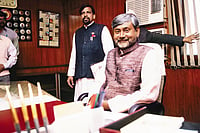On the economic side of things, the general perception is that the government hasn’t quite met the expectations, which were and still remain quite high. In fact, there is a further, new-found surge in expectations in recent times. I have been going on election trips for the past 20 years with a group of journalists—we’re called the ‘limousine liberals’, because we travel by cars to rural areas. Last month, on one such trip, we stopped in a village near Guna in Madhya Pradesh. It was 2 pm, and the village seemed deserted. No one in sight, except for a woman. We asked her version of what was happening, development-wise.
Soon, other women joined the conversation. Some said they had to bribe the sarpanch to get their toilet built, but that toilets were being built. Some complained they hadn’t obtained funds under the Pradhan Mantri Awas Yojna. Despite the notes of discontent, I was happy to see that women were assertive about their complaints. This is a mega transformation. For the bottom 60-70 per cent, India has never had it so good. What do I mean? Look at the LPG chulhas, wherever you go, you can see them having replaced coal and wood. Two women in this schedule caste village invited me to see their homes. One of them complained that she was yet to get the funds promised for building a house. But the situation has improved on the whole. What started as Indira Awas Yojna never succeeded as much as it has succeeded now. People are getting benefits and this has raised legitimate expectations.
Coming to India’s macro performance, I had developed an index a year ago incorporating GDP growth and inflation relative to the past. I found out that on both counts, this is the best macro environment India has ever had. Tell me, when did we last have seven per cent growth and 3.5 to 4 per cent inflation?
As for farmers, there’s no doubting that the past four years have not been the best. However, recall the circumstances. Both 2014-15 and 2015-16 were consecutive drought years, something that has only happened on five occasions in the past 150 years, and not once since the mid-1960s.
Then you had demonetisation, the “self-imposed drought”. It brought a lot of good to the macro-economy. For the poor and the emerging middle class (about two-thirds of the economy), the ill-effects of demonetisation were short-lived. But the measure brought the top-third under the proper tax net.
Then came the GST. So, in all, four big events happened since 2014: two droughts, demonetisation, and GST. In response, the government has increased welfare payments and corruption is also down, as transfers are made to the recipient’s bank account. The economy is being transformed: tax compliance has improved tremendously, inflation rate is well contained and more welfare payments are going out to the poor than ever before. So what is the ‘problem’ with the macro-management of the Indian economy? The only problem is that the government started off with high expectations, and these expectations have moved higher because of the successful delivery.
The writer is a political economist























